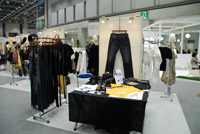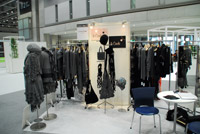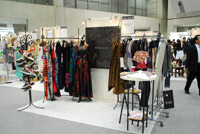| |
 |
| |
 |
| |
Despite the current severe economic environment, ecological materials are attracting wide attention. Ecological materials are not simple to describe, and this sector is profound and deep as it includes environment-friendly items in terms of raw material and processing.
FITTY from Toray Industries, Inc. is an environmental-friendly material using vegetable material, instead of petroleum. One of its raw materials is “propandiol”. In addition to stretch, it possesses excellent shape-retaining property and durability. In the Ecology Textile & Designer Collaboration, Mr. Oharu Ando of Lessthan* is using a high-density fabric from FITTY. Mr. Ando, says, “FITTY was originally for sportswear applications, but I used it for a jacket and pants this time. FITTY can be used for everything. I would like to use FITTY for the spring/summer 2010 collection of my own brand.” He appreciates FITTY, saying, “Although FITTY does not appear to be ecological, it is truly ecological. That’s important.”
Designer Takayuki Suzuki uses only pure organic cotton fabrics for the ikkuna/suzuki takayuki brand. Designer Suzuki explains the reasons for using organic cotton, saying, “In the future, value addition will become a vital factor. It is important to fulfill the psychological satisfaction of consumers. Organic cotton is excellent in quality because matured cotton is used, and it also provides a feeling of satisfaction by being involved in environmental issues.”
In the JFW-JC Collaboration, Designer Suzuki uses organic cotton fabrics from Yamazaki Co., Ltd. and linen fabrics from Hayashiyo Co., Ltd. for his works. Mr. Suzuki says, “I am using a greater amount of fabrics in order to make the most of the qualities and touch of the fabrics.” Because the fabrics are fine, the garment is very light although a lot of fabrics are used. Pure linen fabrics are originally white, and a faint color is added by tea dyeing. The buttons are made from shells.
One of the best-selling fabrics from Showa is a twill woven with a 40-count irregular yarn made from Supima extra-long staple organic cotton. Leading brands in Europe and America are using these fabrics, and a company in Japan is also marketing them; as a result, 97% of the fabrics produced are consumed. Extra-long staple cotton is comfortable to wear, and has durability. People wear a lot of garments that are comfortable. It is also ecological if garments are worn longer, even if the garments are not made from organic cotton. Low-priced apparel is recently popular. Garments that are durable and can be worn many times are a good buy, and consumers are also purchasing the garments with satisfaction, according to the company. |
| |
 |
| |
 |
| |
The new Creator’s Village is located at the right side just after entering the hall. The Creator’s Village is intended for the development of new business opportunities with apparel firms and retailers coming to JFW-JC, and sixteen new brands that are also participating in JFW-IFF are participating. The Creator’s Village is a collection of personalized brands using original materials and production techniques, ranging from items such as bags, hats, leather goods and accessories to apparel dyeing, cut-and-sewn articles and OEM knits.
The cafe is attracting attention for its menu that includes French-style hotdogs, chocolate muffins, yuzu tea, caramel cappuccino, etc.
[Creator’s Village Exhibitors]

|
Lesac
Since Lesac had been an importer of goods from Italy, it is manufacturing mainly products such as bags that have an Italian taste, along with items such as belts, wallets and sandals. The design is simple but sharp, and various types of leather are used, such as reptile and ray skins, of which the finishing and processing are all different. Small-lot OEM production is also possible. |

|
Hishiya
Hishiya Corp. manufactures geta-like sandals and bags using traditional Japanese fabrics, such as Hakata-ori and Nishjin-ori. A wider variation is possible depending on the material. OEM production is possible. Based on the fabric, it is possible to coordinate apparel, bags, sandals, etc. |

|
Junro Rii
This brand features large-sized accessories using embroidery, lace, leaver lace, etc. Main items are necklaces and head dresses. The atmosphere is classical and elegant. A combination of fur and pearls is available for the fall/winter season. |

|
Minerva
The headwear is all designed in Japan, and the patterns and materials are also Japanese made. Since the designs and specifications are made to suit the head of Japanese people, the headwear has a light soft fit unlike mass-produced products. Minerva Co., Ltd. supplies its products to department stores and select shops. |

|
Clio. G
This bag brand uses vintage fabrics (1970s Italian designs) and dead stock fabrics. The designers themselves go to antique shops and markets in search of materials. Since the fabrics have unique characteristics, the design of the bag is simple but modern and warm. |

|
Mitake Sangyo
The origin of Mitake Sangyo Co., Ltd. is a tannery that has been in business for more than 70 years in Asakusa, downtown Tokyo. Mitake Sangyo carries out everything in house from the development of hides to the finishing of final products, such as bags, belts and wallets. About 70% of its production is OEM, and 30% is original products. Original products gradually obtain the unique taste of leather when used over the years. All hides are made in Japan. |

|
Kasane
Kasane is an accessory brand combining silver and cloisonne. The motif is principally nature such as flowers, but it also includes camera motifs, and the accessories are cute and unique. After graduation from a fine arts college, the president worked for an accessory manufacturer for many years, and then became an independent designer undertaking everything from the production of prototypes to finishing. |

|
Swis
Swis started business as an importer of apparel, bags, headwear and stoles, and is active mainly in Germany, Belgium, Denmark and other nations in Europe. This season, “Voler dans le ciel” was launched as an original brand for bottoms. The concept is a mixture of American work and European tailoring, and the fabrics are of detailed design and reproductions of vintage materials. |

|
Needlework Production
Needlework production is presenting products with a Japanese image. Jeans are combined with different materials centering on denim. Traditional Japanese materials and techniques are used to produce original and personalized products. Products include jeans, T-shirts, belts and leather goods, and are unique such as tatami patterns. Business is mainly with select shops. |

|
Naoshi Sawayanagi
Naoshi Sawayanagi is a student and designer, and made his debut as his work was selected for the WholeGarment presentation sponsored by Shima Seiki Mfg., Ltd., and he also won the contest. His products are based on a neonatural concept, and express a unique atmosphere such as with crushed denim. Mr. Sawayanagi earlier visited textile production districts in Japan, and was very much impressed with the greatness of Japanese fabrics. Since then, he has been particular about material and silhouette. |

|
Taka International
Taka International is marketing bags that are mainly hand made. The design image changes every season. The bags are excellently crafted and very useful. All of the products on display can be produced on an OEM basis. The materials are fabrics, synthetic leather and genuine leather, depending on the price. |

|
Nine Hills
Its main products are men’s wear. The brand name is Garden Tokyo. The designer is from an Urahara shop, and the inspiration for its styles comes from original Japanese street culture. All materials are made in Japan. OEM production is also possible for women’s wear. |

|
Fancyworks
Fancyworks manufactures accessories, stoles, lapels, bags and headwear mainly from handmade-like torsion lace. The base cloths produce a natural atmosphere with the use of natural materials such as linen and cotton of natural colors, along with pure wool. The design features a collage of various laces in different materials. Lace products imported from Europe and America are also sold. |

|
Vanilla
The brand name is Slow Clothes. Time is taken to elaborately perform embroidery, applique, dyeing, printing and other handworks, and the products have a deep taste and modern-day style. The main manufacturing base is located in India, and the materials are also purchased in India. The analog feeling is interesting. |

|
Le Cercle
Le Cercle undertakes everything from planning to the production of knits and cut-and-sewn articles. The house brands are Junko Kito and Le Cercle. OEM production is possible for Le Cercle. The company is particular about the manufacturing of fabrics, and a characteristic is the combination of cut-and-sewn and different materials. |

|
Madonna
The traditional “bingata” dyeing technique of Okinawa is matched with the design, and various dyeing techniques are combined, such as dip dyeing, bingata dyeing and discharge printing. Originally a dyer and wholesaler in Okinawa, Madonna Inc. has information on traditional bingata dyeing, and always has about 50 bingata fabrics in stock. It is also possible to dye products such as original apparel items, accessories and sundry goods. |
|
| |
 |
| |
 |
| |
Swarovski Japan Ltd. has been having a joint exhibition since last year, together with two licensed distributors and five licensed application centers for Crystallized - Swarovski Elements, a brand name for high-class cut crystal glass that is used on materials. Many people visited the booths from the first day. Mr. Tomu Yoshinaga, Marketing Management Manager, says, “Many of the participating companies say that the effects of the exhibition are already appearing.”
Crystallized - Swarovski Elements is the only brand for cut crystal glass that is used on materials. In 2006, it was registered as a product brand, and two business systems started last year. It should be noted that the seven companies (i.e., the two licensed distributors and five licensed application centers in Japan) is the largest number in the world for a single nation. |
| |
 |
| |
 |
| |
The forum from 14:00 on April 8th was joined by Ms Laurie Pressman, Vice-President of Pantone, Inc. She talked about the close relationship between colors and strategy.
Using various video images of art, commercials, fashion shows and nature, Vice-President Pressman explained the color-strategy relationship, “In our keenly competitive modern society, it is important to be a careful and clever observer with an extensive range of view in order to maintain competitiveness. Colors are one of the most important elements for attracting the interest of people, and an effective use of colors can establish the image of a company or product.” Many people including freshmen attended the forum, and nearly all of the seats were occupied. Listeners jotted down comments about the relationship between colors and company, brand, product and consumer, along with effective methods of using colors. |
| |
 |
| |
 |
| |
At the Dyeing Creation Village for the promotion of collaboration between different industries (and B2B cooperation) in Japan Tex-promotion, a Business Interchange Meet was held on the evening of April 8th, and brought together dyeing and processing companies participating in this Village and textile firms. Sixty-three persons from 40 companies participated in this Meet. Chairman Kaihara expressed his hope, saying, “I hope that by promoting an interchange in the industry, between industries, vertically among industrial sectors and companies, the collaboration will further heighten Japan’s world-renowned processing technology, and create new buds for future business.” After the technologies of dyeing and processing companies were introduced, the interchange was held in booths at the Village. |
| |
 |
| |
 |
| |
 |
Takisada Nagoya (Booth B-07)/Tokai Senko (Booth B-06)
- Booth Collaboration -
Takisada Nagoya Co., Ltd. and Tokai Senko K.K. had a joint booth this time. Among fabric samples from Tokai Dyeing, all of the processed fabrics of Takisaka Nagoya were displayed on one wall of the booth. The booth was basically separate and independent for each company, but the flooring was kept the same, and the booth wall was removed to produce an image of collaboration.
The wall of the Takisada Nagoya booth said “Please come again” in Nagoya dialect. The cause of stagnant sales is not limited to the recession, but also because of an excess number of stores. By reducing the number of retail shops, distributor demand is expected to decrease, while actual demand is likely to grow. In order to avoid a homogeneous trend, differentiation is necessary by virtue of shifting from the risk in sales of fabrics in stock to risk in the raw material. In order to do so, “joint creation” is important through man-to-man negotiations. That’s why it says, “Please come again.”
Based on the trend toward materials that have a wet sticky feeling, Tokai Dyeing presented “J-Dip”, a new impregnation processing technique. The impregnating materials are urethane, paraffin and oil. “J-Dry” is a new processing technique for producing a natural dry touch. There is a corner for hanger samples of fabrics that have been processed in different ways, so that visitors can see the difference in touch and expression.
|
 |
Hayashiyo (Booth F-05)
- Fine-Count Linen Fabrics Woven on Shuttle Looms -
Hayashiyo Co., Ltd. is producing fine-count linen fabrics. In October 2008, the company replaced some of its rapier looms with shuttle looms. By doing so, it can weave fine-count linen that is difficult to weave, and these fabrics are gaining popularity. By using Chinese-made yarn, the fabrics can be priced reasonably.
Hayashiyo had 20 double-width rapier looms before the replacement. Six of the looms were scrapped, and 12 shuttle looms of 44-inch width and equipped with dobby were installed. When the shuttle looms were introduced, the company newly hired three to four skilled workers. Since fine-count linen yarn easily breaks during hank dyeing and cheese winding, cheese winding is performed in house.
Fabrics made from 60-count linen yarn are well received by casual wear firms. Many companies are looking for weavers who can weave difficult-to-weave fine-count linen fabrics, and despite the current severe economic situation, the company is said to have been operating at full capacity since April.
|
 |
Takisada Osaka (Booth N-08)
- Transition of Trends Displayed on Panels -
Takisada Osaka Co., Ltd. is using half of its booth to display the transition of trends from 1980s to the spring/summer 2010 season. 1980s fashions are attracting attention, and especially have a fresh impression on the young generation who know little about these fashions.
Computers have been installed in the other half of the booth for registration to the Textile Depot. The company is promoting registration to enhance the company’s recognition among students and young designers. Many apparel firms and general buyers have also registered. |
|
| |
 |
| |
 |
| |
Ms Ryoko Kato, Mr. Seiji Ishimoda, Designers of Lep Luss
Since it is hard to visit each and every weaver, JFW-JC is very convenient and useful for us. We have visited mainly business partners this time, and we saw an extremely lightweight organdie that is very attractive for the spring/summer season. We also picked up a number of new business partners. Lep Luss uses only Japanese-made fabrics with the exception of some materials, and we manufacture our garments only in Japan.
Since we come here to find good fabrics, it is important to meet people.
Compared to the past, the invitation card and display space have become more refined and sophisticated. We also like the atmosphere, but prefer to see more fabrics and accessories for the spring/summer season. The fabric samples placed on the small table at the entrance of each booth are also nice. It also lessens the possibility of the fabric sample being overlooked.
On the other hand, we think that apparel firms will skip the Creator’s Village. It might be better to change its location and make its aim and intention easier to understand. |
| |
 |
|
